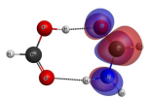EPJ D Colloquium - Recent advances in the application of the Schwinger multichannel method with pseudopotentials to electron-molecule collisions
- Details
- Published on 18 June 2015

A new Colloquium paper published in EPJ D describes recent advances in the use of the Schwinger multichannel method and considers potential future applications of the technique. Based on the Schwinger variational principle for the scattering amplitude, the Schwinger multichannel method was designed to account for exchange, polarization and electronically multichannel coupling effects in the low-energy region of electron scattering from molecules with arbitrary geometry.
The applications of the method became more ambitious with the availability of computer power combined with parallel processing, the use of norm-conserving pseudopotentials and improvement of the description of target excited states (minimal orbital basis for single configuration interaction). The most recent applications involving 33 and 45 electronically open channels for phenol and ethylene molecules, represent good examples of the present status of the method.
The authors (Romarly F. da Costa, Márcio T. do N. Varella, Márcio H. F. Bettega, and Marco A. P. Lima) review the strategy and point out potential new directions for the application of the method in its full extension.
Romarly F. da Costa, Márcio T. do N. Varella, Márcio H.F. Bettega, and Marco A.P. Lima (2015),
Recent advances in the application of the Schwinger multichannel method with pseudopotentials to electron-molecule collisions,
European Physical Journal D, DOI: 10.1140/epjd/e2015-60192-6




